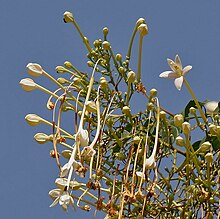Millingtonia
| Millingtonia | |
|---|---|

| |
| Scientific classification | |
| Kingdom: | Plantae |
| Clade: | Tracheophytes |
| Clade: | Angiosperms |
| Clade: | Eudicots |
| Clade: | Asterids |
| Order: | Lamiales |
| Family: | Bignoniaceae |
| Tribe: | Oroxyleae |
| Genus: | Millingtonia L.f. |
| Species: | M. hortensis
|
| Binomial name | |
| Millingtonia hortensis L.f.
| |
| Synonyms[1] | |
| |
Millingtonia hortensis, the tree jasmine or Indian cork tree, is the sole species in the genus Millingtonia,
In the name Millingtonia hortensis, Millingtonia is named for
Millingtonia Avenue in Lucknow is named after Millingtonia hortensis.[5]
Description
The tree grows to a height of between 18 and 25 metres and has a spread of 7 to 11 metres. It reaches maturity between 6 and 8 years of age and lives for up to 40 years. It is a versatile tree which can grow in various soil types and climates with a preference for moist climates.[4] Like Nyctanthes arbor-tristis, it blooms in night and sheds during morning. Flowers give very pleasant smell.
Stem
The tree is evergreen and has an elongated pyramidal stem. The soft, yellowish-white wood is brittle and can break under strong gusts of wind.[4]
Leaf
The leaf is
Flower
The white flowers come as large
Fruit and seed
The fruit is a smooth flat capsule and is partitioned into two. It contains broad-winged seeds.[2] The fruits are fed on by birds which aid in seed dispersal. In cultivation, the viability of seeds is low unless they are sown immediately after the fruit ripens, so the plant is generally propagated through cuttings.
Uses
The tree is considered ornamental and the pleasant fragrance of the flowers renders it ideal as a garden tree. The wood is also used as timber and the bark is used as an inferior substitute for cork.
Views of different aspects
-
In Hyderabad, India
-
In Hyderabad
-
In Hyderabad
-
In Hyderabad
-
In Hyderabad
-
In Hyderabad
References
- ^ "The Plant List: A Working List of All Plant Species". Retrieved 2 December 2014.
- ^ a b c d Lindley, John; Moore, Thomas (1866). The Treasury of Botany. Longmans, Green & Co. pp. 1260. Retrieved 1 May 2011.
genus Millingtonia.
- ISBN 978-81-7017-335-9. Retrieved April 30, 2011.
- ^ ISBN 978-0-07-463218-5. Retrieved April 30, 2011.
- ISBN 978-81-89422-50-9. Retrieved 30 April 2011.
- ISBN 978-0-07-043435-6. Retrieved April 30, 2011.
- ISBN 978-0-07-460373-4. Retrieved April 30, 2011.
- ISBN 978-3-540-41017-1. Retrieved 30 April 2011.






